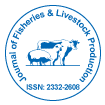开放获取期刊获得更多读者和引用
700 种期刊 和 15,000,000 名读者 每份期刊 获得 25,000 多名读者
索引于
- 哥白尼索引
- 谷歌学术
- 夏尔巴·罗密欧
- 打开 J 门
- 学术钥匙
- 电子期刊图书馆
- 参考搜索
- 研究期刊索引目录 (DRJI)
- 哈姆达大学
- 亚利桑那州EBSCO
- OCLC-世界猫
- 学者指导
- SWB 在线目录
- 虚拟生物学图书馆 (vifabio)
- 普布隆斯
- 欧洲酒吧
- 卡迪夫大学
有用的链接
开放获取期刊
分享此页面
抽象的
The Main Factors Affecting Growth Performance of Oreochromis niloticus L., (1758) in Aquaculture System
Bantalem Akalu
Aquaculture is a practice of cultivating aquatic animals and plants under artificial environmental conditions in controlled or semi-controlled conditions. It is one of the fastest food production sectors in the world due to high animal protein demand and, plays a significant role in contributing food security and reducing employment rate of the rising world population. Despite the enormous potential for aquaculture production in Ethiopia, it remains more potential than actual practice. This review is under taken with recent available articles to assess the main factors affecting growth performance of Oreochromis niloticus in aquaculture. The major factors affecting growth performance of O. niloticus in aquaculture are genetic variation, feeding rate and frequency, stocking density, feed composition and water quality. These factors can affect feed conversion ratio, weight gain, feeding efficiency, reproduction and health of O. niloticus. Water quality also influences feeding, growth, disease burdens, and survival rates. The most important water quality parameters in aquaculture are pH, temperature, ammonia, dissolved oxygen and salinity. For a better growth performance of O. niloticus in culture system, the feed should constitute protein, lipid, carbohydrate, vitamin and minerals with an optimum quantity. Generally, better growth performance of O. niloticus can be achieved in aquaculture through adjusting the optimum quantity of feed with adequate feeding rate and frequency, increase genetic variability, keeping biological density in a good proportion and monitoring of water quality in a regular manner.

 English
English  Spanish
Spanish  Russian
Russian  German
German  French
French  Japanese
Japanese  Portuguese
Portuguese  Hindi
Hindi